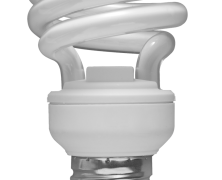Nearly a decade ago, governments around the world began mandating a move away from traditional incandescent light bulbs as a way to help meet broader energy management goals. At the time, those curly white compact fluorescent bulbs seemed like the best alternative, but further research has revealed the dangers of fluorescent lighting in any form. All fluorescent lights – from industrial tubes to the spiraled household bulbs – contain mercury, and this is the main concern. Mercury is a heavy metal that is highly toxic in even tiny amounts, a serious deterrent to the adoption of fluorescents on a widespread consumer scale. Exposure to mercury is associated with a whole range of major health concerns, from neurological and behavioral disorders to liver, kidney, and central nervous system problems. Mercury exposure is thus an unavoidable concern with this technology, driving many towards complete replacement of fluorescent lights. Aside from the environmental effects of mining and manufacturing, there’s of course the danger associated with product breakage. As we all know, accidents happen, and when a fluorescent bulb or tube breaks, a small amount of mercury vapor is released. This small amount is so dangerous that the U.S. Environmental Protection Agency has filled an entire page on its website with detailed instructions on what to do should this happen to you. Several important steps should be taken immediately, a tall order given most will not have these steps available at their fingertips. Worse, liquid mercury can also be released, finding its way down through carpet fibers and cracks in concrete flooring. This liquid eventually evaporates into the atmosphere, causing local contamination and substantially increased health risks. Even if we manage to avoid breakage, there’s still a major problem when it comes time to dispose of fluorescent bulbs...






